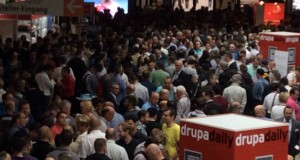The 300,000 printers battling through the crowded aisles at the world’s biggest trade fair cannot help but be assailed by the big five themes at this year’s show, themes which will reverberate into print in the coming years, reports Wayne Robinson from drupa 2016. Humanless printing, digital packaging, inkjet printing, cloud computing, and hybrid presses are central to drupa 2016, all of which promise to enable printers to either slash costs or open up new opportunities. Heidelberg, the world’s biggest offset press manufacturer – although no longer the biggest drupa exhibitor – sprang a surprise when it revealed it is developing its presses to become self-managing manufacturing units, which not only print by themselves but also organise their own servicing, order their own consumables, and plan their own production schedule. Then Fujifilm announced it has developed a lights-out book production solution, in partnership with US outfit Epac, which uses robots, and can produce a book printed and finished every six seconds. Print production without any human activity has arrived on the horizon, how far away that horizon is we don’t know. Printing folding carton digitally looks set to be the next big opportunity with vendor after vendor lining up to tell printers that the $400bn folding carton market is ripe for digital printing, and please buy our system. KBA has partnered with Xerox, EFI is launching its own 30 metre long printer, Screen is in partnership with BHS which makes most of the world’s corrugators, Heidelberg and Landa both have B1 inkjet folding carton printers – well Landa promises one – Konica Minolta had a technology showcase on the floor, wide formats developer Durst launched a folding carton printer, HP has its upgraded Indigo 20000 and the list when on. Inkjet was everywhere, with Kodak launching Ultrastream which will not be ready for three years, even Xerox launching inkjet printers, in its case webfed and sheetfed versions, Konica launched its sheetfed KM-1 now known as the AccuriJet, Canon launched its i300 A3 inkjet printer and revealed it is working on a sheetfed B2 six-colour inkjet press, Xeikon launched its Trillium, not strictly inkjet, more a liquid toner along Indigo lines, Komori had its version of the KM-1, the Impremia. Cloud computing – which was so prevalent at drupa it is hard to imagine a world without it – is great news for smaller printers who have little or no IT infrastructure. It means they can access any software they want or need, no need to install or buy upgrades, no compatibility issues as everyone is working from the same version, and no IT costs, just the monthly fee or in some cases you can pay job by job. The logic behind the emergence of hybrid presses is compelling, why would an inkjet manufacturer bother to build a press chassis and sheet transport system when they already exist in the offset world, and why would an offset manufacturer bother to develop its own inkjet heads when they can work together. So Heidelberg and Fujifilm, Komori with Konica Minolta and with Landa, KBA with Xerox and HP, Ryobi with Miyakoshi, all make perfect sense. That leaves manroland, which is taking a different approach and adopting its folding lines for high speed inkjet webs. And whither the star of drupa four years ago Landa – well no presses available to buy, but the first ones going into beta tests next year, an ‘order’ for 20 from Vistaprint parent Cimpress and a strategic partnership with QuadGraphics. However both Heidelberg and manroland have pulled out of partnering with Landa. As for drupa itself, well it never fails to inspire, the aisles are crowded, and it is now on a three year cycle – although not everyone is pleased with that, Xerox for instance were openly calling for a reversion back to four years – but there is little doubt this year’s show marked the start of a new era in printing, with the prospect of no people, with cloud computing, with digital folding carton, inkjet printing and hybrid presses.
Big themes emerge at drupa


